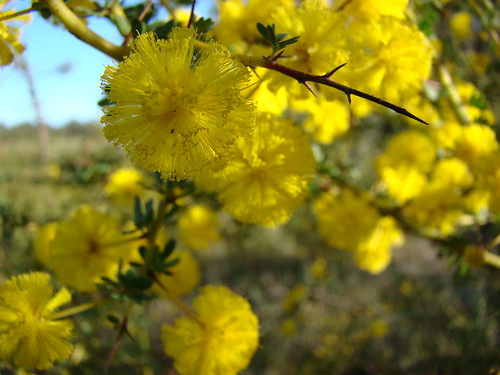Is a Flowering plant genius of fast growing shrubs and tall trees belonging to thesubfamily,Mimosoideae,family,
Fabaceae.The most common known type is the African type,
know as the Bullhorn acacia with large pinnately compound leaves,purple thorns, and a classic shape.But there are many other acacias that have pretty golden yellow flowers, banana like leaves, and Fusilli pasta like fruits!!Many of these Acacias live in Australia.The leaves color ranges form silver,silver blue,light green,greenish yellow, and dark green.
Acacias with silver colored or silver blue colored leaves contains tiny white hairs that cover the leaf.This hairs may reduce sunlight intake,form the blistering sun,or protect form frost.But some acacias have silver blue leaves without hairs.This is because the plant has release microscopic mineral crystals making the leave look silver in color.
The generic name derives from ακακία (akakia), the name given by early Greek botanist-physician Pedanius Dioscorides to the medicinal tree A. nilotica in his book Materia Medica.This name derives from the Greek word for its characteristic thorns, ακις (akis, thorn).The species name nilotica was given by Linnaeus from this tree's best-known range along the Nile river.Acacias are also know as thorntrees, whistling wattles or wattles.The tree is evergreen and flowers in spring to summer.The flowers are often round and yellow,but some acacia flowers are rather long, for example,the ear leaf acacia as seen in the following image:
Ear leaf acacia flowers

Common acacia flowers:

Acacias then produce greenly blue,to greenly purple fruits that look like beans(Anyway, acacias are related to beans)....
Some Acacias produce curly fruits looking like a Fusilli pasta, such as the Fruits of the Hickory Wattle, also known as the Big leaf Acacia(Acacia mangium)(See the leafs and tree below the following images)
Fusilli pasta like seed pods of the Acacia Mangium Fruit
Acacia Mangium seed podsAcacia Mangium dried fruits
Acacia Mangium dried seed pods
Acacia Mangium Fruit(Light green leaf)
Acacia Mangium Branches
Acacia Mangium
Acacia Mangium Tree
Acacia Mangium Fruit(fresh)
Acacia Mangium Fruit(fresh)
Small Acacia Mangium trees ready for planting
(still posting!please come back to the post 2-4 days later...Or subscribe!)
Strange Looking Type of Acacias Gallery:
Harrow Wattle
Acacia acanthoclad
This Acacia has tiny leaves, Only 1 to 2mm long, to 0.2 to 0.6 Wide,But can Grow up to 2m tall.The Golden flowers flowers at August To October and is found in the wild in western Australia and Southern Australia.The Species is threatened due to overgrazing Kangaroos.
Acacia acanthoclad
Leafless Rock Wattle
Acacia aphylla
Is a Strange succulent-like Acacia with spiny,leafless stems, and grows to between 0.9 and 2.5 metres in height. It produces yellow flowers between August and October (late winter to mid spring) in its native range
Leafless Rock Wattle
Acacia aphylla
Leafless Rock Wattle
Acacia aphylla
Leafless Rock Wattle stem
Acacia aphylla
Winged Wattle stem
Acacia alata
Winged Wattle
Acacia alata
Winged Wattle yellow Flowered
Acacia alata
Queensland Silver Wattle
Acacia podalyriifolia
This species of Acacia is a perennial tree which is fast-growing and widely cultivated. It is native to Australia but is also naturalised in Malaysia, Africa, India and South America. Its uses include environmental management and it is also used as an ornamental tree.
Acacia podalyriifolia Tree
Acacia podalyriifolia
Acacia podalyriifolia branch
Other Types of Acacia:
Earleaf Acacia
(Acacia auriculiformis)
Acacia auriculiformis, commonly known as Auri, Earleaf acacia, Earpod wattle, Northern black wattle, Papuan wattle, Tan wattle, is a fast-growing, crooked, gnarly and thorny tree in the family Fabaceae. It is native to Australia, Indonesia, and Papua New Guinea. It grows up to 30m tall.It is
Introduced to Hong Kong as a Shade Tree.
Earleaf Acacia Tree
Earleaf Acacia flowers
Earleaf Acaica Fruit pods





























No comments:
Post a Comment